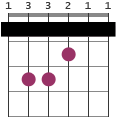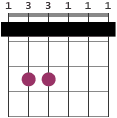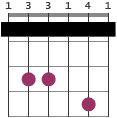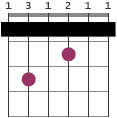Capo 1 chords
Capo on the first fret is actually, aside from other perspectives, a tip for beginners who find it rather challenging to play on steel stringed guitar and have problems pressing down strings. It “hurts” less with a capo on since it lessens the pressure that is needed to press down a string. For a player that has passed the early beginner phase, capo 1 can make techniques like hammer-on and pull-off easier by the same reasons.
On the other hand, some aspects of guitar playing are more difficult with a capo on. You have to recount frets. For example, fingerings at the third position will now be on fourth position and so on. You have to start thinking in both relative and absolute positions when it comes to fingerings.
Chord with capo 1
C#
D#
D#m
F
Fm
Fm7
F7
G#
A#
A#m
Comments
C#m with capo 1 is possible, but the fingerings are easier with Am shape capo 4 or
Gm shape capo 6.
G#m with capo 1 is possible, but the fingering is easier with Em shape capo 3 or
Dm shape capo 5.
Note that Db = C#, Eb = D#, Ab = G#, Bb = A#.
What happens in capo 1?
Concerning the common open chords, the capo on first fret will change chord as follows:
C > C#
Am > Bbm
D > D#
E7 > F7
Gmaj7 > G#maj7
This is just a few examples.
Among other things, this means that the key of A, for example, will shift to the key of A sharp with capo on the first fret.
This capo position is, for example, great when playing B flat and E flat chords, major, minor as well as dominant chords comes often with easy fingerings.
The new sound can be exciting since variation can fuel the inspiration. If you write own songs, capo 1, can be a great inspiration for new songs. You will hear the sound a little different and perhaps automatically try new chords progression and position on the fretboard you haven’t done otherwise.
C chords with capo 1
Many C chords are played as barre chords with the capo on first fret. Some of the other options are:
- C can be played Capo 3 - A shape, Capo 5 - G shape.
- Cm can be played Capo 3 - Am shape.
- Cmaj7 can be played Capo 3 - Amaj7 shape, Capo 5 - Gmaj7 shape.
C7 and Cm7 can be played with B7 and Bm7 shapes, respectively. Also, C11 is played with the B11 shape.
D chords with capo 1
Many D chords are played as barre chords with the capo on first fret.
Some of the other options are:
- D can be played Capo 2 - C shape, Capo 5 - A shape.
- Dm can be played Capo 5 - Am shape.
- Dmaj7 can be played Capo 5 - Amaj7 shape, Capo 2 - Cmaj7 shape.
- Dm7 can be played Capo 5 - Am7 shape.
Also, Dadd9 can be played as X5425X.
E chords with capo 1
Many E chords are played with suboptimal fingerings with the capo on first fret. Some of the other options are:
- E can be played Capo 2 - D shape, Capo 4 - C shape.
- Em can be played Capo 2 - Dm shape.
- Em7 can be played Capo 2 - Dm7 shape.
- Esus4 can be played Capo 2 - Dsus4 shape, Capo 4 - Csus4 shape.
- Esus2 can be played Capo 2 - Dsus2 shape, Capo 4 - Csus2 shape
E6 can be played with a C6 shape with the root on the 7th fret.
G chords with capo 1
Many G chords are played as barre chords with the capo on first fret. Some of the other options are:
- G can be played Capo 3 - E shape, Capo 5 - D shape.
- Gm can be played Capo 3 - Em shape, Capo 5 - Dm shape.
- G7 can be played Capo 3 - E7 shape, Capo 5 - D7 shape.
- Gmaj7 can be played Capo 3 - Emaj7 shape, Capo 5 - Dmaj7 shape.
- Gm7 can be played Capo 3 – Em7 shape, Capo 5 – Dm7 shape.
Also, G6 can be played with a F6 shape with the root on the 5th fret.
A chords with capo 1
Many A chords are played as barre chords or in inconvenient positions with the capo on first fret. Some of the other options are:
- A can be played Capo 2 - G shape, Capo 5 - E shape.
- Am can be played Capo 5 - Em shape.
- A7 can be played Capo 2 - G7 shape, Capo 5 - E7 shape.
- Amaj7 can be played Capo 2 - Gmaj7 shape, Capo 5 - Emaj7 shape.
- Am7 can be played Capo 5 – Em7 shape.
Some alternatives to avoid 9 chords with the root on 12 fret are A9 as 43434X, Amaj9 as 43534X and Am9 as 4243XX.
B chords with capo 1
Many B chords are played as barre chords with the capo on first fret. Some of the other options are:
- B can be played Capo 2 - A shape, Capo 4 - G shape.
- Bm can be played Capo 2 - Am shape.
- B7 can be played Capo 2 - A7 shape, Capo 4 - G7 shape.
- Bmaj7 can be played Capo 2 -Amaj7 shape, Capo 4 - Gmaj7 shape.
- Bm7 can be played Capo 2 – Am7 shape.
Also, Bdim7 can be played as X23030.
F barre can be played as open E
Not everyone is fond of barre chords. One of the most common barre chords, if not the most common, is F major. This can in “capo 1 mode” be played much more comfortable as an open E major. The same is of course true with Fm, Fm7, F7 and so on, which can be played as Em, Em7 and E7 shapes respectively.
Bb barre can be played as open A
Similar is the case of the barred Bb chords. These can now be played as open A chords.
Progressions
A progression to try is D#m – D#m/C# – D#m/B – A#7sus4
See also: Capo 2 chords | Capo 3 chords | Capo 4 chords









